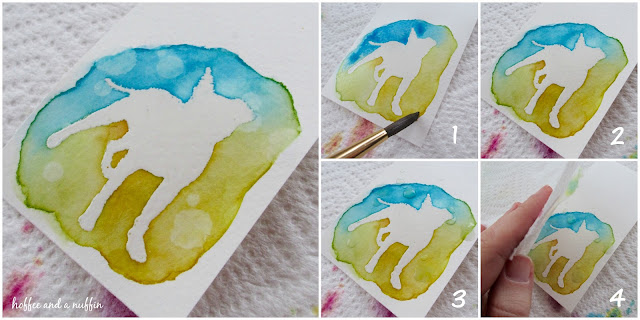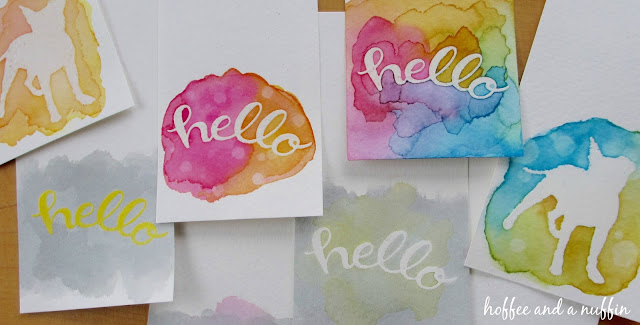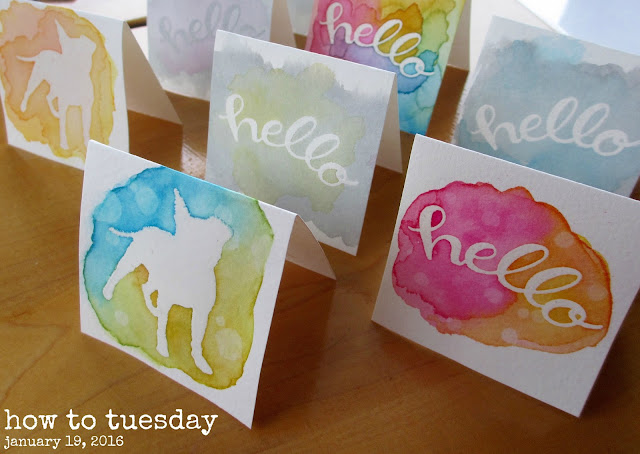Hello! I like to practice new techniques on small bits of paper and I think that note cards are a great way to use those finished pieces. I've recently discovered distress inks and I'm having a lot of fun playing with them and using them along with my rubber stamps. One technique I'm enjoying is an embossed resist technique, with resist ink as a watercolor paint. In this "how to" I'll share with you the supplies I have in my personal collection and how I use them. (I am in no way endorsing any of these products, nor am I suggesting that these are the only brands/types you should use. Though I do enjoy these products, there are still others I have yet to discover and add to my personal collection.)
Supplies needed:
watercolor paper cut to 2.5" x 5"
white (pigment) or clear (watermark) ink
clear embossing powder
heat tool (or oven)
pencil (optional)
eraser (optional)
distress ink or watercolor paint
brush
water
palette, lid, or laminated card
paper towels
I began by preparing my watercolor paper with the stamped and embossed image.
Once my cards were embossed, I was ready to begin painting. Distress ink can be pressed directly to a smooth surface to discharge ink. With a wet brush, we can pick up color and even blend colors on the surface before adding it to the paper. TIP: If the ink dries on the plastic, simply wet it again to reactivate it. This is a good way to conserve ink, too. There's no need to wipe the plastic clean unless the colors become muddy. It can be used again at a later time. The melted embossing powder acts as a barrier, resisting ink and paint in the areas of the paper it was applied. Pretty cool, huh?

1. Color your paper with wet ink.
2. Allow it to dry. A heat tool can be used to speed up the drying process.
3. Water droplets can be added to create a "bleached" effect. Let the drops sit on the paper for several seconds. (30 seconds? A minute? You decide.)
4. Use a paper towel to blot the water droplets and reveal your finished painting.
I wondered if it would have been easier to work on ONE large piece of paper that could be cut down later, so this example was a test for comparison. I cut this paper down to 10" x 5". That would give me four cards. I used a pencil and ruler to very lightly mark lines so I knew where to stamp. I also wanted to compare different inks while at the same time using the same clear embossing powder. From left to right the inks are: Memento Luxe, Wedding Dress; ColorBox, White; ColorBox, Silver; and ColorBox, Yellow. I hadn't used my black distress ink yet, so I thought this test would be a good project to use it for. I painted black ink across the length of the paper, then layered colored ink over the first three cards, adding extra black ink over the last. I really like the way they turned out. It's a different effect, and for our gloomy, rainy skies today it seemed rather appropriate. Once the ink was dry, I erased all of my lines and cut the cards down to 2.5".
NOTE: My preference for white ink would be the ColorBox pigment ink because it was much more "wet" than the Memento Luxe. Memento Luxe is GREAT! But for this project, I think the ColorBox was a better pigment ink.
Don't forget to go back and erase those lines! (I do like my Sakura eraser.)
I didn't tape my cards down before painting to keep them flat. When they were dry I stuck them between the pages of a heavy book and let them sit for a bit. It works for me. My cards are informal and handmade. I think the little irregularities add to their handmade charm.
I hope this demonstration offers some inspiration and I look forward to seeing what you come up with. As always, thank you for following along on my handmade journey. Happy crafting!







No comments:
Post a Comment